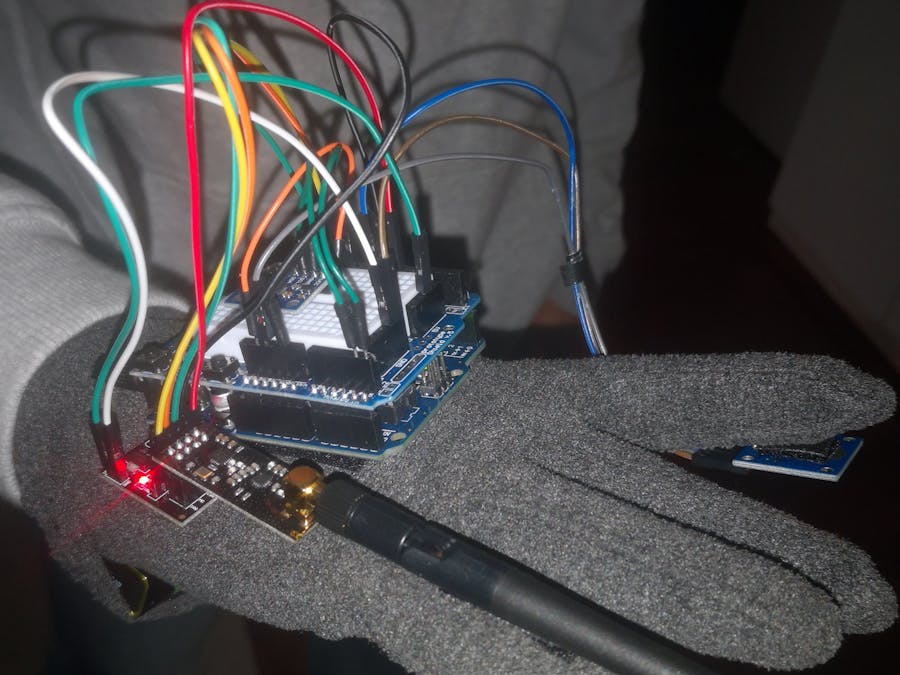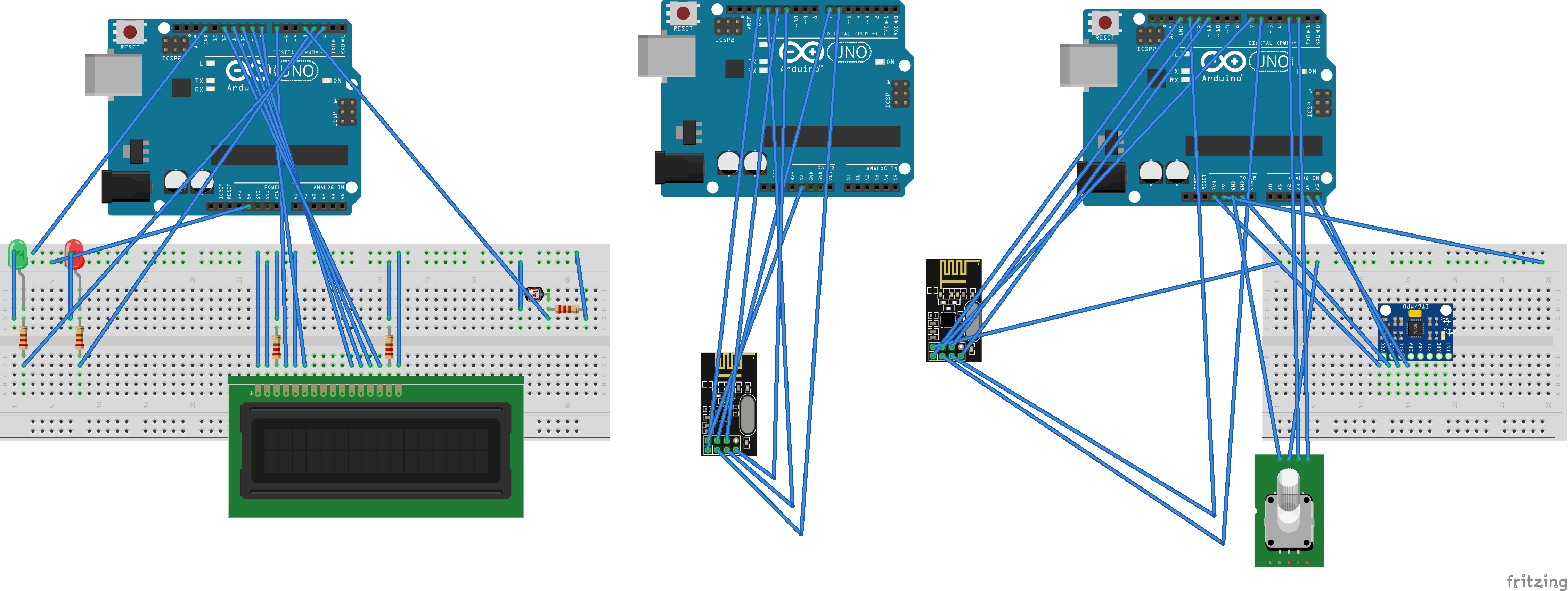Hardware components | ||||||
_wzec989qrF.jpg?auto=compress%2Cformat&w=48&h=48&fit=fill&bg=ffffff) |
| × | 1 | |||
_ztBMuBhMHo.jpg?auto=compress%2Cformat&w=48&h=48&fit=fill&bg=ffffff) |
| × | 1 | |||
 |
| × | 1 | |||
 |
| × | 1 | |||
| × | 2 | ||||
 |
| × | 1 | |||
 |
| × | 1 | |||
 |
| × | 2 | |||
 |
| × | 1 | |||
 |
| × | 2 | |||
 |
| × | 1 | |||
 |
| × | 1 | |||
Hand tools and fabrication machines | ||||||
| ||||||
| ||||||
Hello everyone,
we are Carlo Albani, Lorenzo Amaducci and Lorenzo Ferraiuolo from Liceo Scientifico A.Oriani, in Ravenna, Italy.
Our Arduino project is called "the Gesture Glove", a glove capable of substituting a computer mouse.
It has a gyroscope, that permits to move into the screen, a touch sensor, positioned on the forefinger, a rotaring encoder which replace the mouse wheel and a Calibrating Box that follow us during the calibration.
Firtly, we understand how the gyroscope works, and then we use it as a cursor.
The Construction Phase consisted in putting all the hardware in the glove, in the following order:
1. Gyroscope, 2. The battery, 3. Touch sensor, 4. Wireless sensor, 5. The rotaring encoder.
The Battery assemble is shown here:
That's the complete Gesture glove:
After this we builded the Calibrating Box, which is essential since the gyroscope need to set, and for doing it, he needs a flat surface.
The Calibrating Box has an LCD Display that gives you the necessary information, it also had two leds:
the first is red and is turning on during the calibration (you have 10 seconds for positioning the glove, in this period of time the led flashes), then when it ends, a green lights turn on and you can start to use the Gesture Glove.
Here's the link for our project's official account, you can go and check the final test, we would really appreciate you stopping by!
We sincerely hope you enjoyed our work and the effort we put in, have a nice day and let us know if you have any question!
INSTAGRAM LINK: https://www.instagram.com/gesture_glove/?hl=it
#include "Wire.h"
#include "I2Cdev.h"
#include "MPU6050_6Axis_MotionApps20.h"
#include "Calibration_func.h"
#include "MPU6050_data_func.h"
float ypr[3];
String testo;
bool calibrate=false;
int lastMSB=0,lastLSB=0;
long lastencoderValue=0;
const uint8_t encoderPin1=2,encoderPin2=3,touch_pin=8;
volatile int lastEncoded=0;
volatile long int encoderValue=0;
MPU6050 mpu(0x68);
void setup(){
Serial.begin(115200);
Wire.begin();
TWBR=24;
/*
mpu.initialize();
mpu6050_calibration(mpu);
mpu.dmpInitialize();
mpu.setDMPEnabled(true);
attachInterrupt(0,dmpDataReady,RISING);
packetSize=mpu.dmpGetFIFOPacketSize();
*/
pinMode(touch_pin,INPUT);
pinMode(encoderPin1,INPUT_PULLUP);
pinMode(encoderPin2,INPUT_PULLUP);
attachInterrupt(0,updateEncoder,CHANGE);
attachInterrupt(1,updateEncoder,CHANGE);
}
void loop(){
if(!calibrate){
testo="";
while(Serial.available()) testo+=(char)Serial.read();
if(testo!=""){
mpu6050_calibration(mpu);
mpu.dmpInitialize();
mpu.setDMPEnabled(true);
attachInterrupt(0,dmpDataReady,RISING);
packetSize=mpu.dmpGetFIFOPacketSize();
calibrate=true;
}
}else{
get_data(mpu,ypr);
Serial.print(ypr[0]*180/M_PI);
Serial.print(";");
Serial.print(ypr[1]*180/M_PI);
Serial.print(";");
Serial.print(ypr[2]*180/M_PI);
Serial.print(";");
Serial.print(digitalRead(touch_pin));
Serial.print(";");
Serial.println(encoderValue);
}
}
void updateEncoder(){
int MSB=digitalRead(encoderPin1),LSB=digitalRead(encoderPin2),encoded=(MSB<<1)|LSB,sum=(lastEncoded<<2)|encoded;
if(sum==0b1101||sum==0b0100||sum==0b0010||sum==0b1011) encoderValue++;
if(sum==0b1110||sum==0b0111||sum==0b0001||sum==0b1000) encoderValue--;
lastEncoded=encoded;
}
#include<LiquidCrystal.h>
int valore;
String testo;
bool calibrated=false,calibrating=false;
uint8_t red_led=3,green_led=2,photo_resistor=A4;
LiquidCrystal lcd(7,8,9,10,11,12);
void setup(){
Serial.begin(115200);
lcd.begin(16,2);
pinMode(photo_resistor,INPUT);
pinMode(green_led,OUTPUT);
pinMode(red_led,OUTPUT);
digitalWrite(green_led,LOW);
digitalWrite(red_led,LOW);
}
void loop(){
valore=analogRead(photo_resistor);
if(!calibrating&&!calibrated&&valore<50){
lampeggio(red_led,10,500);
digitalWrite(red_led,HIGH);
Serial.println("S");
calibrating=true;
}else if(calibrated&&valore>300){
digitalWrite(green_led,LOW);
digitalWrite(red_led,LOW);
calibrating=false;
}if(calibrating){
testo="";
while(Serial.available()) testo+=(char)Serial.read();
if(testo!="") lcd.clear();
if(testo=="FINISHED"){
digitalWrite(green_led,HIGH);
digitalWrite(red_led,LOW);
calibrated=true;
}
lcd.setCursor(0,0);
lcd.print(testo);
}
}
void lampeggio(uint8_t led,int n,int millisec){
for(int i=0;i<n;++i){
digitalWrite(led,HIGH);
delay(millisec);
digitalWrite(led,LOW);
delay(millisec);
}
}
import pyautogui
import serial
import time
vel_sens=0.1
def strTofloat(data):
try:
num=data.split('.')
return int(num[0])+int(num[1])/10**len(num[1])
except IndexError:
return int(data)
arduino=serial.Serial("COM4",115200,timeout=0.05)
arduino2=serial.Serial("COM3",115200,timeout=0.05)
pyautogui.PAUSE=0
pyautogui.FAILSAFE=False
data=0; k=0;
x=0; y=0; z=0; t=0; s=0; x0=0; y0=0; z0=0; t0=0; s0=0;
calibrated=False
calibrating=False
arduino.flushInput()
arduino2.flushOutput()
while True:
if not calibrating and not calibrated:
data2=arduino2.readline()
if data2:
print(data2)
arduino.write(data2)
calibrating=True
else:
try:
data=arduino.readline()
x,y,z,t,s=[strTofloat(i) for i in str(data)[2:-5].split(';')]
except ValueError:
if(data):
arduino2.write(data)
print(data)
continue
try:
vy=y-y0
vz=z-z0
vx=x-x0
vs=s-s0
if calibrated:
if(t): pyautogui.mouseDown()
elif(t<t0): pyautogui.mouseUp()
pyautogui.scroll(vs*20)
pyautogui.moveRel(-vy*vel_sens,-vz*vel_sens,duration=0)
elif k>0 and abs(vx)<0.5 and abs(vy)<0.5 and abs(vz)<0.5:
k+=1
if k==50:
x0,y0,z0=x,y,z
calibrated=True
calibrating=False
arduino2.write(b"FINISHED")
elif k==0:
x0,y0,z0=x,y,z
k=1
else: k=0
except Exception as i:
print(i)
t0=t
s0=s
arduino.close()
arduino2.close()
uint8_t mpuIntStatus; // holds actual interrupt status byte from MPU
uint16_t packetSize; // expected DMP packet size (default is 42 bytes)
uint16_t fifoCount; // count of all bytes currently in FIFO
uint8_t fifoBuffer[64]; // FIFO storage buffer
Quaternion q; // [w, x, y, z] quaternion container
VectorFloat gravity; // [x, y, z] gravity vector
uint8_t teapotPacket[14] = { '$', 0x02, 0,0, 0,0, 0,0, 0,0, 0x00, 0x00, '\r', '\n' };
volatile bool mpuInterrupt = false; // indicates whether MPU interrupt pin has gone high
void dmpDataReady(){
mpuInterrupt=true;
}
void get_data(MPU6050 mpu,float ypr[3]){
//ypr[0]=0.0f; ypr[1]=0.0f; ypr[2]=0.0f;
mpuIntStatus=mpu.getIntStatus();
fifoCount=mpu.getFIFOCount();
if(mpuIntStatus&0x02){
while(fifoCount<packetSize) fifoCount=mpu.getFIFOCount();
mpu.getFIFOBytes(fifoBuffer,packetSize);
fifoCount-=packetSize;
mpu.dmpGetQuaternion(&q,fifoBuffer);
mpu.dmpGetGravity(&gravity,&q);
mpu.dmpGetYawPitchRoll(ypr,&q,&gravity);
}
}
#define BUFFERSIZE 1000 //Amount of readings used to average, make it higher to get more precision but sketch will be slower (default:1000)
#define ACEL_DEADZONE 8 //Acelerometer error allowed, make it lower to get more precision, but sketch may not converge (default:8)
#define GIRO_DEADZONE 1 //Giro error allowed, make it lower to get more precision, but sketch may not converge (default:1)
void calibration(MPU6050);
void meansensors(MPU6050);
int16_t ax,ay,az,gx,gy,gz;
int mean_ax,mean_ay,mean_az,mean_gx,mean_gy,mean_gz,ax_offset,ay_offset,az_offset,gx_offset,gy_offset,gz_offset;
void mpu6050_calibration(MPU6050 accelgyro){
accelgyro.initialize();
Serial.println("Calibration");
delay(3000);
Serial.println(accelgyro.testConnection()?"Success":"Epic Fail?");
delay(1000);
accelgyro.setXAccelOffset(0);
accelgyro.setYAccelOffset(0);
accelgyro.setZAccelOffset(0);
accelgyro.setXGyroOffset(0);
accelgyro.setYGyroOffset(0);
accelgyro.setZGyroOffset(0);
delay(1000);
Serial.println("Reading sensors");
meansensors(accelgyro);
delay(1000);
Serial.println("Calculating offsets?");
calibration(accelgyro);
delay(1000);
meansensors(accelgyro);
Serial.print("Just a minute?");
accelgyro.setXGyroOffset(gx_offset);
accelgyro.setYGyroOffset(gy_offset);
accelgyro.setZGyroOffset(gz_offset);
accelgyro.setZAccelOffset(az_offset);
}
void meansensors(MPU6050 accelgyro){
long i=0,buff_ax=0,buff_ay=0,buff_az=0,buff_gx=0,buff_gy=0,buff_gz=0;
do{
accelgyro.getMotion6(&ax, &ay, &az, &gx, &gy, &gz); // read raw accel/gyro measurements from device
if (i>100 && i<=BUFFERSIZE+100){ //First 100 measures are discarded
buff_ax=buff_ax+ax;
buff_ay=buff_ay+ay;
buff_az=buff_az+az;
buff_gx=buff_gx+gx;
buff_gy=buff_gy+gy;
buff_gz=buff_gz+gz;
}if (i==BUFFERSIZE+100){
mean_ax=buff_ax/BUFFERSIZE;
mean_ay=buff_ay/BUFFERSIZE;
mean_az=buff_az/BUFFERSIZE;
mean_gx=buff_gx/BUFFERSIZE;
mean_gy=buff_gy/BUFFERSIZE;
mean_gz=buff_gz/BUFFERSIZE;
}
delay(2); //Needed so we don't get repeated measures
}while(++i<=BUFFERSIZE+100);
}
void calibration(MPU6050 accelgyro){
int ready;
ax_offset=-mean_ax/8;
ay_offset=-mean_ay/8;
az_offset=(16384-mean_az)/8;
gx_offset=-mean_gx/4;
gy_offset=-mean_gy/4;
gz_offset=-mean_gz/4;
do{
ready=0;
accelgyro.setXAccelOffset(ax_offset);
accelgyro.setYAccelOffset(ay_offset);
accelgyro.setZAccelOffset(az_offset);
accelgyro.setXGyroOffset(gx_offset);
accelgyro.setYGyroOffset(gy_offset);
accelgyro.setZGyroOffset(gz_offset);
meansensors(accelgyro);
Serial.println("...");
if (abs(mean_ax)<=ACEL_DEADZONE) ready++;
else ax_offset=ax_offset-mean_ax/ACEL_DEADZONE;
if (abs(mean_ay)<=ACEL_DEADZONE) ready++;
else ay_offset=ay_offset-mean_ay/ACEL_DEADZONE;
if (abs(16384-mean_az)<=ACEL_DEADZONE) ready++;
else az_offset=az_offset+(16384-mean_az)/ACEL_DEADZONE;
if (abs(mean_gx)<=GIRO_DEADZONE) ready++;
else gx_offset=gx_offset-mean_gx/(GIRO_DEADZONE+1);
if (abs(mean_gy)<=GIRO_DEADZONE) ready++;
else gy_offset=gy_offset-mean_gy/(GIRO_DEADZONE+1);
if (abs(mean_gz)<=GIRO_DEADZONE) ready++;
else gz_offset=gz_offset-mean_gz/(GIRO_DEADZONE+1);
}while(ready!=6);
}
Albani Carlo Amaducci Lorenzo Ferraiuolo Lorenzo










Comments
Please log in or sign up to comment.